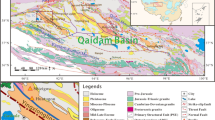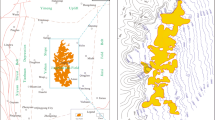Abstract
Xinglongtai field has been an important petroleum-producing area of Liaohe Depression for 30 years. Oil exploration and production were the focus of this field, but the gas was ignored. This study examined twenty five gas samples with the purpose of determining the gas genetic types and their geochemical characteristics. Molecular components, stable carbon isotopic compositions and light hydrocarbons were also measured, and they proved that microbial activity has attacked some of the gas components which resulted in unusual carbon isotopic distributions. Propane seems to be selectively attacked during the initial stage of microbial alteration, with abnormally lower content compared to that of butane as well as anomalously heavy carbon isotope. As a consequence, the carbon isotopic distribution among the gas components is partially reverse, as δ13C1<δ13C2<δ13C3>δ13C4. Besides, n-alkanes of C3+ gas components are preferentially attacked during the process of microbial alteration. This is manifested that n-alkanes are more enriched in 13C than corresponding iso-alkanes. As a result, the concentrations of n-alkanes become very low, which may be misleading in indentifying the gas genetic types. As to four gas samples, light hydrocarbon compositions display evidence for microbial alteration. The sequence of hexane isomers varies obviously with high content of 2,3-DMC4, which indicates that they have been in the fourth level of extensively bacterial alteration. So the geochemical characteristics can be affected by microbial alteration, and recognition of microbial alteration in gas accumulations is very important for interpreting the natural gas genetic types.
Similar content being viewed by others
References
Baily N.J.L., Krouse H.R., Evans C.R., and Rogers M.A. (1973) Alteration of crude oil by waters and bacteria—Evidence from geochemical and isotope studies [J]. AAPG. 57, 1276–1279.
Blair N.E. and Aller R.C. (1995) Anaerobic methane oxidation on the Amazon shelf [J]. Geochimica et Cosmochimica Acta. 18, 3707–3715.
Blanc P.H. and Connan J. (1992) Origin and occurrence of 25-norhopanes: A statistical study [J]. Organic Geochemistry. 18, 813–828.
Coleman D.D., Risatti J.B., and Schoell M. (1981) Fractionation of carbon and hydrogeon isotopes by methane-oixdizing bacteria [J]. Geochimica et Cosmochimica Acta. 45, 1033–1037.
Dai Jinxing (1990) A brief discussion on the problem of the geneses of the carbon isotopic series reversal in organogenic alkane gases [J]. Natural Gas Industry. 10, 15–20 (in Chinese with English abstract).
Dai Jinxing, Xia Xinyu, Qin Shengfei, and Zhao Jingzhou (2004) Origins of partially reversed alkane δ13C values for biogenic gases in China [J]. Organic Geochemistry. 35, 405–411.
Dai Jinxing, Qin Shengfei, Tao Shizhen, Zhu Guangyou, and Mi Jinkui (2005) Developing trends of natural gas industry and the significant progress on natural gas geological theories in China [J]. Natural Gas Geoscience. 16, 127–142 (in Chinese with English abstract).
Fuex A.N. (1977) The use of stable carbon isotopes in hydrocarbon exploration [J]. Journal of Geochemical Exploration. 7, 155–188.
Galimov E.M. (1988) Sources and mechanisms of formation of gaseous hydrocarbons in sedimentary rocks [J]. Chemical Geology. 71, 77–95.
Gao Gang, Huang Zhilong, Liang Hao et al. (2008) Analysis on selectivity biodegradation of natural gas in Yanmuxi Oilfield of Tuha Basin [J]. Acta Petrolei Sinica. 29, 494–498 (in Chinese with English abstract).
George S.C., Boreham C.J., Minifie S.A. et al. (2002) The effect of minor to moderate biodegradation on C5 to C9 hydrocarbons in crude oils [J]. Organic Geochemistry. 33, 1293–1317.
Héroux Y., Chagon A., and Bertrand R. (1979) Compilation and correlation of major thermal maturation indicators [J]. AAPG. 63, 2128–2144.
Hu Tilin, Ge Baoxiong, Zhang Yigang, and Liu Bin (1990) The development and application of fingerprint parameters for hydrocarbons absorbed by source rocks and light hydrocarbon in natural gas [J]. Petroleum Exploration and Experiment. 12, 375–379 (in Chinese with English abstract).
James A.T. (1983) Correlation of natural gas by use of carbon isotopic distribution between hydrocarbon components [J]. AAPG. 67, 1176–1191.
James A.T. and Burns B.J. (1984) Microbial alteration of subsurface natural gas accumulations [J]. AAPG. 68, 957–960.
Katz B.J., Narimanov A., and Huseinzadeh R. (2002) Significance of microbial processes in gases of the South Caspian basin [J]. Marine and Petroleum Geology. 19, 783–796.
Kinnaman F.S., Valentine D.L., and Tyler S.C. (2007) Carbon and hydrogen isotope fractionation associated with the aerobic microbial oxidation of methane, ethane, propane and butane [J]. Geochimica et Cosmochimica Acta. 71, 271–283.
Kniemeyer O., Musat F., Sievert S.M. et al. (2007) Anaerobic oxidation of short-chain hydrocarbons by marine sulphate-reducing bacteria [J]. Nature. 449, 898–901.
Kotelnikova S. (2002) Microbial production and oxidation of methane in deep subsurface [J]. Earth Science Reviews. 58, 367–395.
Larter S.R., Wilhelms A., Head I. et al. (2003) The controls on the composition of biodegraded oils in the deep subsurface, part 1: Biodegradation rates in petroleum reservoir [J]. Organic Geochemistry. 34, 601–613.
Larter S.R. and Diprinio R. (2005) Effects of biodegradation on oil and gas field PVT properties and the origin of oil rimmed gas accumulations [J]. Organic Geochemistry. 36, 299–310.
Lebedew W.C., Owsjansikow W.M., Mogilewskij G.A. et al. (1969) Fraktionierung der kohlenst off isotope durch mikrobiologis Prozesse in der biochemischen zone [J]. Z Angew Geology. 15, 621–624.
Leythaeuser D., Schaefer R.G., and Corndord C. (1979) Generation and migration of light hydrocarbon (C2–C7) in sedimentary basin [J]. Organic Geochemistry. 1, 191–204.
Lin Renzi (1992) Light hydrocarbons Technique and Its Application in Oil and Gas Exploration [M]. China University of Geosciences Press, Wuhan (in Chinese).
Ma Anlai, Zhang Shuichang, Zhang Dajiang et al. (2005) The advances in the geochemistry of the biodegraded oil [J]. Advances in Earth Science. 20, 449–454 (in Chinese with English abstract).
Milner C.W.D., Gogers M.A., and Evans C.R. (1977) Petroleum transformations in reservoirs [J]. Journal of Geochemical Exploration. 7, 101–153.
Pallasser R.J. (2000) Recognising biodegradation in gas/oil accumulations through the δ13C compositions of gas components [J]. Organic Geochemistry. 31, 1363–1373.
Rice D.D. and Claypool E.G. (1981) Generation, accumulation, and resource potential of biogenic gas [J]. AAPG. 65, 5–25.
Roeling W.F.M., Head I.M., and Larter S.R. (2003) The microbiology of hydrocarbon degradation in subsurface petroleum reservoirs: Perspectives and prospects [J]. Research in Microbiology. 154, 321–328.
Rowland S.J., Alexander R., Kagi R.I. et al. (1986) Microbial degradation of aromatic components of crude oils: A comparison of laboratory and field observations [J]. Organic Geochemistry. 9, 153–161.
Sassen R., Roberts H.H., Carney R. et al. (2004) Free hydrocarbon gas, gas hydrate, and authigenic minerals in chemosynthetic communities of the northern Gulf of Mexico continental slope: Relation to microbial processes [J]. Chemical Geology. 205, 195–217.
Wang Wanchun, Zhang Linye, Liu Wenhui et al. (2005) Effects of biodegradation on the carbon isotopic composition of natural gas—A case study in the bamianhe oil field of the Jiyang Depression, eastern China [J]. Geochemical Journal. 39, 301–309.
Wang Wanchun, Ren Junhu, Zhang Xiaojun et al. (2006) Geochemical characteristics and origin of low-mature oil-associated gases from south region of Kongdian, Huanghua Depression [J]. Natural Gas Geoscience. 17, 153–159 (in Chinese with English abstract).
Wang Wanchun, Li Junyuan, Tang Hongsan et al. (2007) Genetic characteristics of associated gases from crude oil biodegradation in Gudao oilfield, Jiyang Depression [J]. Oil and Gas Geology. 28, 427–432 (in Chinese with English abstract).
Wang Wanchun, Li Nengshu, Liu Wenhui et al. (2008) Simulating test of microbial degradation of natural gas [J]. Natural Gas Industry. 28, 34–37 (in Chinese with English abstract).
Ward B.B., Kilpatrick K.A., Novelli P.C., and Scranton M.I. (1987) Methane oxidation and methane fluxes in the ocean surface layers and deep anoxic waters [J]. Nature. 327, 226–229.
Zehender A.J.B. and Brock T.D. (1979) Methane formation and methane oxidation by methanogenic bacteria [J]. Journal of Bacteriology. 137, 420–432.
Zehender A.J.B. and Brock T.D. (1980) Anaerobic methane oxidation: occurrence and ecology [J]. Applied Environmental Microbiology. 39, 194–204.
Zhang Linye, Li Juyuan, Li Xiangchen, and Tang Hongsan (1996) Light hydrocarbon constituents of the biodegradation gas and gas-source correlation [J]. Experimental Petroleum Geology. 18, 88–95 (in Chinese with English abstract).
Zhang Linye and Li Xuetian (1990) The origin of natural gas in the shallow reservoir in Binhai area in Jiyang Depression [J]. Petroleum Exploration and Development. 17, 1–7 (in Chinese with English abstract).
Zyakun A.M., Bondar, V.A., and Namsaraev B.B. (1985) Caron isotope fractionation by methane-oxidizing bacteria [J]. Geokhimiya. 9, 291–297.
Author information
Authors and Affiliations
Corresponding author
Rights and permissions
About this article
Cite this article
Yang, W., Liu, G., Gong, Y. et al. Microbial alteration of natural gas in Xinglongtai field of the Bohai Bay Basin, China. Chin. J. Geochem. 31, 55–63 (2012). https://doi.org/10.1007/s11631-012-0549-3
Received:
Accepted:
Published:
Issue Date:
DOI: https://doi.org/10.1007/s11631-012-0549-3




